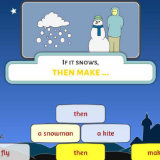Phiên bản Android: Tải phiên bản Android của Endless Spelling Bee
Đang tải game...
Perfect Tense
Đã được chơi 5000 lần.
100% (1/1)
Updated January 2020 - changed 'been' to 'gone' in the first set of content, so that 'go' now matches to 'gone'. The sentence still uses 'been' in the phrase contruction part - 'He has been to America'.
This is a mini-game for practicing perfect tense sentences in English. It is intended to be used by ESL learners to review and reinforce the use of perfect tense.
Hướng dẫn chơi Game:
The game is divided into 3 parts. In the first part, you have to match simple verb forms to their perfect tense conjugations - for example, eat matches to eaten. The aim of this part is to review the verb forms before starting to make sentences and also to remind/cement the idea that perfect tense uses different verb forms. In the second part, you have to look at the image and click on the words to form an accurate perfect tense sentence - for example, 'she has eaten lunch'. The aim here is to practice making accurate sentences and to test the students on word order and grammar issues. In the third part, you have to look at the image and click on one of 3 sentences. The 3 sentences here only have minor differences and the aim to give students practice in noticing correct grammar for perfect tense.
The sentences used in this game are arranged into 4 sets of content. These are grouped according to the different uses of perfect tense. The first set covers basic use of perfect tense to describe things that you have done at a non-specific point in time. For example, 'she has eaten lunch'. Some life experiences are also included in this set, such as 'seen an elephant' and 'graduated from college'. The aim with this set is to cover all the basic verbs and try to get phrases that people are likely to hear in everyday life, such as 'done homework' or 'passed the test'. This set also varies between singular and plural and between positive and negative. The intention with this is to expose students to all the different forms that basic perfect tense phrases can take.
The second set of phrases concerns life experiences - sentences that would answer 'have you ever x?' questions. A contrast was created between sentences stating the number of times something has been done and sentences stating that something has never been done. This is important as the sentence order is different for 'never' phrases. The aim here is to expose learners to these kind of life experience phrases. I tried to use phrases that could be typically be experienced in everyday like - e.g. 'had an injection' or 'failed the test'. But typically these sentences are unusual in nature, such as 'eaten a spider'.
The third set concerns duration and how long you have done something for. This is one of the main uses of perfect tense - to describe an action that you continue to do from the past up until present, for example: 'lived in London' or 'played the trumpet'. The key issue with these sentences is whether they are used with 'for' or 'since'. If there is a specific time mentioned at which the action began, then 'since' is used. Whereas, if you just have a duration - e.g. '5 years', then 'for' is used. This distinction is quite important and so it is important for students to get practice with sentences that contrast this.
The final set concerns phrases involving the words 'just', 'already' and 'yet'. These signify slightly different meanings for perfect tense and so contrasting them is quite useful. Phrases with 'yet' are used for situations in which an action hasn't taken place, but is likely to do so in the future - e.g. "the store hasn't opened yet". 'Just' phrases are used to describe events that have recently happened with evidence showing. For example, 'he has just washed the car' with the car showing as clean and the water and soap visible. Similarly, 'already' phrases describe events that have taken place. I chose to use 'already' for situations when there is evidence in the present. This means that there is a lot of overlap between the 'just' and 'already' phrases, but the options available for students to click on should preclude any confusion. The aim of this content is to practice making phrases using these words, with a particular focus on correct word order. I really think that practicing these phrases like this is useful for learners.
The images used in this game are quite specific in nature. The problem with creating images for perfect tense is that it is quite a hard concept to represent visually. For something like 'he is flying a kite', it is quite easy to represent - you just show a boy flying a kite and it directly matches the meaning; however, for something like, 'he has already flown a kite', the meaning is much more subtle and difficult to show visually. The solution used in this game is to have the actions separated from the person. For example, in the sentence 'she has eaten lunch', the action of eating lunch is shown in a bubble and then person to whom the sentence refers is shown next to the bubble, with a thumbs-up to signal having done this action. I think that this is a good solution as I think this closely resembles the way the meaning is understood. In perfect tense, the action is not really being performed by the person, rather it exists as a concept that they relate to, so I think it makes sense to separate it off in this way. To further explain, in the simple sentence 'he is flying a kite' you have the boy as the subject and the kite as the object being flown. The sentence is about how the boy relates to the kite. Conversely, in the perfect tense sentence 'he has flown the kite' the boy is still the subject and the kite the object; however, the sentence is more about how the boy relates to the action of flying the kite. And, to some extent, the action of flying the kite can be thought of as like an object in the sentence.
So in accordance with this perspective, the images are split into 2 with the action in a bubble and subject of the sentence shown next to the bubble. The subject/person, also indicates how they relate to the action. In the first set, this is done with a thumbs-up to indicate something has been done, and a no-hands to show that something hasn't been done. In the second set, the person holds up fingers to indicate the number of times they have done the action (also with a number displayed in a circle). For the 3rd set, each person holds up a sign showing the time to be used in the phrase - the task then is for the student to work out which word (for/since) to use with that time. Finally, for the last set of content, the phrases used are somewhat different. They are more concerned with things that have happened with evidence clear in the present. Because of this, they don't use the split bubble type images.
The game gives points for each correct answer and takes points for incorrect clicks. The maximum scores possible is 23000.
Phân loại Game:
GAME HAY: Phiên bản Android Game Đoán màu Cờ 182+ quốc gia Guess The Flag's Color
GAME TƯƠNG TỰ
6276
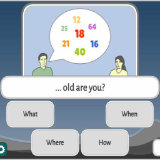

Questions Game
7763
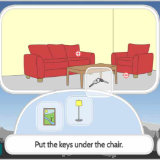

Prepositions Game
4703


Present Simple Verbs
4998
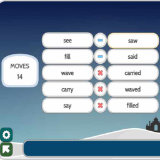

Past Tense
4400


Fast Phrases
6239
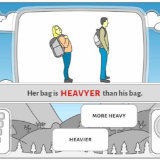

Comparatives
6754
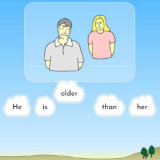

Falling Clouds
5000


Perfect Tense
5367
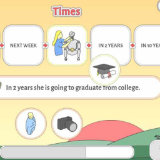

The Future
10642
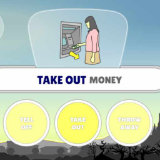

Phrasal Verbs
21300
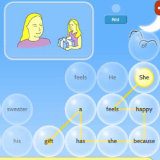

Grammar Bubbles




